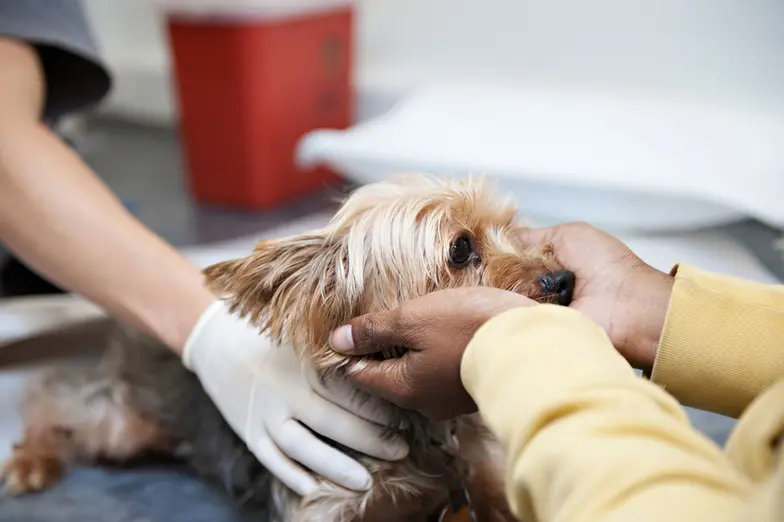Canine Infectious Respiratory Disease Complex: Prevention, Management, & Treatment

Canine Infectious Respiratory Disease Complex (CIRDC), sometimes called kennel cough, is a particular concern for shelters (as well as other facilities where large numbers of dogs are housed in close proximity to one another, such as boarding facilities) because it is highly contagious and can result in serious disease if not quickly addressed. Prompt identification and diagnosis of cases, treatment of infected dogs, and implementation of control measures are all critical.
CIRDC can be caused by a variety of viruses and bacteria that often result in the same clinical signs of disease, and many dogs are infected with more than one pathogen. For this reason, the particular cause of a CIRDC case cannot be distinguished based on clinical signs alone.
Some of the most common viral causes include:
- Canine parainfluenza virus (CPiV)
- Canine adenovirus type 2 (CAV2)
- Canine distemper virus (CDV)
- Canine herpesvirus (CHV)
- Canine influenza virus (CIV)
- Canine respiratory coronavirus (CRCoV)
- Canine pneumovirus (CnPnV)
Important bacterial pathogens include:
- Bordetella bronchiseptica
- Streptococcus zooepidemicus
- Mycoplasma cynos
Prevention
Three keys to preventing widespread CIRDC in your dog population are vaccination, stress reduction, and sanitation.
Vaccination
CIRDC is not a vaccine-preventable disease, but proper vaccination protocols are important in minimizing the frequency and severity of infectious respiratory disease in shelter dogs. While vaccines are commercially available for many of the more common and serious pathogens associated with the disease complex, others (including canine respiratory coronavirus, herpesvirus, and pneumovirus as well as Mycoplasma spp. and Streptococcus equi subsp. zooepidemicus) do not exist or are not currently available for use in the United States.
It is critical that animals entering the facility receive appropriate vaccinations at or before their entry to the shelter in order to maximize effectiveness and reduce the risk of disease outbreaks. Staff training should be periodically provided to ensure that vaccinations are being handled appropriately (e.g., kept refrigerated and reconstituted prior to use) and administered in compliance with shelter protocols.
Core vaccinations for shelter dogs (PDF) include a modified live injectable product containing canine distemper virus, canine parvovirus, and canine adenovirus-2 as well as intranasal vaccination using a product that contains both Bordetella bronchiseptica and canine parainfluenza virus.
Vaccination against canine influenza may be appropriate in some facilities, but immunity should not be expected until approximately one week following the second dose (e.g., three weeks following initial vaccination).
Stress and Crowding Reduction
Perhaps the most critical of all control measures is reducing stress and crowding, so it’s important that shelters understand and operate within their capacity for care. Direct physical benefits of stress reduction include reductions in circulating cortisol levels and decreased barking, which in and of itself can help to reduce respiratory irritation and aerosol spread of the causative agents. Ensuring adequate housing and providing enrichment, out-of-kennel time, and socialization with people and other friendly dogs are all important means of reducing stress.
Crowding is an extremely potent stressor for dogs. High-density housing, particularly when young dogs and those originating from different environments are co-housed with dogs in the facility, is a significant risk factor for disease.
Length of stay in a shelter environment has been shown to be a risk factor for development of clinical signs associated with CIRDC pathogens. Keeping fewer dogs in the facility at any given time, particularly by reducing the length of time they spend in the shelter, generally improves the level of animal care and sanitation that can be provided and reduces the risk of direct or indirect contact with infected animals.
Sanitation
Most of the various CIRDC pathogens are easy to kill with basic cleaning and disinfection practices. (Canine adenovirus is a notable exception; disinfectants with efficacy against non-enveloped viruses [e.g., sodium hypochlorite or similar products, potassium peroxymonosulfate, accelerated hydrogen peroxide] must be used.) Adequate sanitation also helps limit the transmission of pathogens throughout the facility.
In addition to good cleaning and disinfection practices, staff assignments should be made to limit the spread of disease and reduce fomite transmission. Restricting access to small subsets of the population, using appropriate personal protective equipment (PPE), and using dedicated supplies in limited areas of the facility will all help minimize disease spread.
Clinical Signs
The most common signs of CIRDC include:
- Coughing
- Sneezing
- Eye discharge
- Nasal discharge
- Elevated respiratory rate
- Shortness of breath/difficulty breathing
- Fever
For most CIRDC pathogens, the time between infection and the development of clinical signs (i.e., incubation period) is less than 2 weeks (with the exception of canine distemper virus which has a longer incubation period). Dogs may shed infectious virus before clinical signs appear and may continue to do so for 2 weeks or longer after recovery, depending on the pathogen.
Transmission
CIRDC pathogens are most commonly transmitted through:
- Aerosolization
- Direct contact
- Fomite transfer
Diagnosis
Initial diagnosis of CIRDC can be made based on the appearance of clinical signs. However, the causative agent (i.e., virus, bacteria, or both) of the disease cannot be determined based on clinical signs alone.
When disease spreads rapidly through the facility, large numbers of dogs are affected, or disease is particularly severe, then a respiratory PCR panel should be performed at a diagnostic laboratory to determine the specific causative agent. Respiratory PCR panels using combined samples from both nasal and oropharyngeal swabs are recommended.
Treatment
Individual Animal Care
In-shelter treatment is usually symptomatic and supportive in nature (e.g., maintaining adequate hydration and nutrition) and aimed at preventing secondary bacterial infections. If a bacterial agent is identified or highly suspected, then a course of antibiotics may be indicated.
Antibiotic therapy is indicated for primary and secondary bacterial infections, commonly occurring in shelter settings. Although it is ideal to make therapeutic choices based on sensitivity results, this is very difficult to do on a consistent basis for all infected dogs due to financial and logistical restraints. Initial therapy can be prescribed based on likely pathogens and basic information about the antibiotic selected, but no one choice will be appropriate for all cases.
The use of steroids, cough suppressants, and expectorants is generally not recommended in the shelter environment. Because coughing is often exacerbated by excitement, exercise (particularly pulling on the leash), and barking, appropriate environmental modifications should be made to limit these triggers.
More severely affected dogs require more aggressive treatment, which may include hospitalization, intravenous fluid therapy, oxygen support, nebulization, and coupage. If intensive treatments are not possible, or if inadequate response to treatment is noted in individual cases, consider transferring these dogs to a private veterinary facility or humane euthanasia.
Population Considerations
Humane conditions and medical care, as well as adequate isolation space to prevent transmission to the rest of the population, must be available. Depending on the size of the facility, number of staff, and number of infected dogs, it may become necessary to temporarily halt intake to avoid jeopardizing the health of incoming animals and avoid the need for depopulation. The need for such drastic action is rare and should be utilized only as a carefully considered last resort.
Isolation
Timely removal of clinically affected dogs to strict isolation must be undertaken to limit the spread of disease. Dogs should be moved as soon as possible once clinical signs are noted, as the intensity of shedding does not necessarily correlate with the severity or duration of clinical signs observed. For this reason, complete separation of exposed dogs from unexposed and newly arrived dogs may be necessary.
Contact with infected dogs should be restricted to key staff and volunteers. Whenever possible, these individuals should not work with other dogs. If this is not feasible, appropriate personal protective equipment (PPE) must be worn and dogs should be handled in isolation only after handling healthy animals in the general population.
Depending on the nature of the disease and available resources for treatment, placement into foster care, release to rescue organizations, or hospitalization at a private veterinary clinic may be appropriate options for infected dogs.
Resources and Downloads
We have lots more on this subject:

